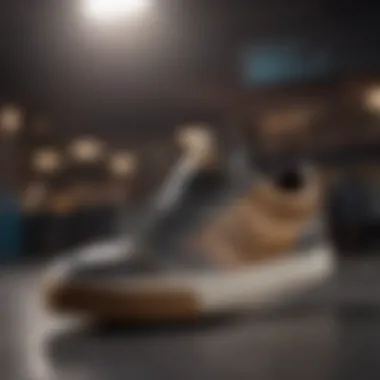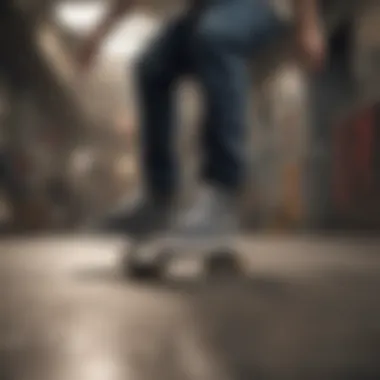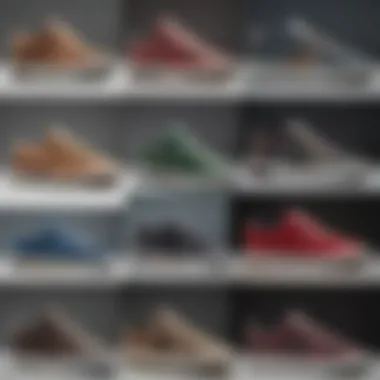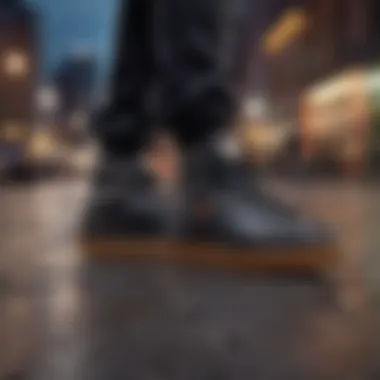Exploring Original Skate Shoes: Design and Performance Insights


Intro
Skateboarding has grown from a niche recreational activity to a global phenomenon, mirroring the evolution of its footwear. This article examines the integral role of original skate shoes within this culture, focusing on their design intricacies and performance attributes. The journey starts with the history of skateboarding, tracing its roots and showcasing how the design of skate shoes has adapted over time.
The History of the Sport
Origin and Evolution
Skateboarding began in the late 1940s and early 1950s in California. Surfers sought ways to mimic their sport on land, leading to the creation of the first skateboards. Initially simple wooden planks with roller skate wheels, these boards lacked the specialized footwear that defines modern skate shoes.
As the sport evolved through the 1960s and 70s, so did the needs of skaters. Skate shoes were not just footwear; they became essential gear. The need for shoes that provided grip, durability, and comfort in various skating styles became apparent. This transformation was vital in pushing skateboarding from a casual pastime to an extreme sport.
Milestones and Influences
Throughout the years, there have been key milestones in the development of skate shoes. In the 1970s, companies like Vans and Converse began producing shoes that catered specifically to skaters. These brands introduced features like padded collars and sturdy soles to withstand the rigors of skateboarding.
The 1980s introduced iconic models, such as the Vans Sk8-Hi and the Nike Bruin. The influence of pro skaters also played a pivotal role in shaping footwear design. Brands collaborated with athletes, allowing their feedback to drive innovations. These partnerships allowed for testing in real-world conditions, leading to improved performance attributes in shoes.
Key Athletes and Pioneers
Prominent figures have shaped the landscape of skate shoes. Tony Hawk, for example, not only revolutionized skateboarding tricks but also influenced sneaker culture. Through partnerships with major brands, he helped usher in the era of signature footwear.
Marc Johnson and Eric Koston are other names who defined skate shoe design. Their contributions to brands like Lakai and Nike SB led to new concepts that blended technical performance with stylish looks. These athletes exemplified the connection between skateboarding and fashion, making skate shoes highly coveted items even outside skate culture.
Skate shoes have become symbols of personal style, reflecting the creativity of both skaters and designers.
Understanding the history of skate shoes provides context to their current design and performance characteristics, showcasing their importance in both skateboarding culture and broader fashion trends. With a solid grasp of the origins and influences of skate shoes, we can delve deeper into their technical aspects in the following sections.
Foreword to Skate Shoes
Skate shoes hold great significance within both skateboarding culture and the broader realm of athletic footwear. This article seeks to illuminate the various aspects that define these shoes, particularly their design and performance components. These shoes are not just tools for enthusiasts; they represent a unique blend of style, comfort, and function, making them essential for skaters and trendsetters alike.
The originality of skate shoes can be traced back to their inception, where design considerations were primarily focused on enhancing performance. Key attributes such as grip, support, and durability are critical for skaters who rely on their footwear to navigate numerous tricks and terrains.
Furthermore, their evolution over the decades has reflected changing tastes, styles, and developments in technology. The importance of skate shoes extends beyond utilitarian needs; they have become cultural icons, influencing fashion and lifestyle trends. As we explore the essence of original skate shoes, we will delve into their defining qualities, historical context, and the factors that contribute to their ongoing appeal.
Defining Original Skate Shoes
Original skate shoes are characterized by their distinctive blend of functionality and style. These shoes are designed with specific skateboarding needs in mind. They offer exceptional grip to maintain traction on skateboards, and a sturdy construction that withstands the demands of various skating styles.
These footwear items are typically low-profile and made from materials that provide both durability and comfort. For instance, leather and synthetic textiles form the outer shell, while cushioned interiors absorb impacts during jumps and landings. Reinforced stitching and toe caps further enhance the longevity of these shoes.
Moreover, original skate shoes should not be mistaken with just any athletic footwear. The skateboarding community values authenticity, and the original designs reflect a unique aesthetic that resonates with skaters. Each shoe design often incorporates elements of street art and subculture styles, making them a canvas of expression for the wearers.
This emphasis on both function and style forms the foundation of what true original skate shoes are all about.
Historical Context
Understanding the historical context of skate shoes is crucial. It reveals how these shoes transitioned from functional footwear to iconic cultural symbols. This section explores two key components: the origins of skate shoes and their evolution through the decades.
The Origins of Skate Shoes


Skate shoes began to surface in the 1970s, crafted primarily by surfers who wanted to translate their love for the ocean to the streets. The shift from surfing to skateboarding necessitated footwear that was designed specifically for grip and maneuverability.
Companies like Vans were among the pioneers, introducing the slip-on design that provided a snug fit while maintaining freedom of movement. The simplicity and function of these early skate shoes laid the foundation for the modern designs we see today. Key elements like the rubber soles and flat profiles were developed to enhance performance on various surfaces.
In these early years, skate shoes were not just gear; they became part of the identity of skaters. They represented a lifestyle choice, merging sports with a rebellious attitude. This cultural significance played a vital role in shaping how skate shoes would evolve in subsequent years.
The Evolution Through Decades
As we moved into the 1980s and 1990s, the evolution of skate shoes accelerated significantly. With the rise of skateboarding as an extreme sport, brands began to innovate aggressively, introducing advanced features to enhance both performance and style.
During the 1980s, companies like Nike and Adidas recognized the potential market and began producing skate shoes. The use of more durable materials, such as suede and leather, became prominent. Shoes like the Nike Air Jordan made their mark, introducing air cushioning technology that provided comfort without compromising performance.
The 1990s witnessed collaborative designs and a blend of streetwear influences. It was not uncommon to see skaters mixed with hip-hop culture. Brands started collaborating with famous skaters, resulting in signature lines that emphasized the individuality of the rider.
In the 2000s and beyond, skate shoes became a mainstay in mainstream fashion. Limited editions and collaborations with artists and designers emerged, blurring the lines between skate culture and high fashion. This evolution not only reflected changing consumer preferences but also affirmed the cultural importance of original skate shoes.
“Skate shoes tell the story of a culture intertwined with individuality, rebellion, and innovation,” a sentiment echoed by many in the skateboarding community.
Today, the journey of skate shoes continues with a focus on sustainability and technology. As we move forward, understanding this historical context is vital. It informs current market trends and emphasizes how deeply rooted skate shoes are within a broader cultural narrative.
Key Features of Original Skate Shoes
Understanding the key features of original skate shoes is essential for grasping their pivotal role in skateboarding culture. These features influence not only the aesthetics but also the performance that skaters demand. The specificity in design elements, material choices, and grip technology ultimately reflects how these shoes enhance a skater's experience. By diving into these aspects, one can appreciate the nuance of what makes a skate shoe truly effective.
Design Considerations
Design plays a vital role in the functionality of skate shoes. Skaters require footwear that supports their movements while still being stylish. Many brands focus on combining practicality and artistic expression. This is evident in various styles -- from low-top to high-top designs.
- Ankle Support: High-top designs offer extra ankle support, essential for performing tricks and avoiding injuries.
- Cushioning: Sufficient padding around the ankle and tongue helps with comfort during long sessions.
- Padded Collars: These enhance fit and feel, allowing for tight but comfortable wear.
Colors and branding also matter. Original skate shoes often reflect personal styles of individual skaters, making them not just tools for performance, but also a canvas for personal expression.
Material Selection
The choice of materials in skate shoe construction significantly impacts their durability and performance. Traditional skate shoes were often made with leather. However, modern advancements have led to a variety of materials being utilized:
- Suede: Provides a sleek look and is generally more durable against wear.
- Canvas: Lighter and more breathable, but may not offer as much durability as leather or suede.
- Synthetic Materials: Offer innovative features such as waterproofing.
Breathability is another aspect that cannot be overlooked. The right materials prevent excess sweat, ensuring comfort for skaters, particularly during extended use. This is essential as discomfort can hinder performance during critical maneuvers.
Grip and Sole Technology
Grip is arguably one of the most critical features of skate shoes, dictating the skater's control over their board. Sole technology has evolved greatly, focusing on enhancing grip while maintaining a balance with durability.
- Vulcanized Soles: This type of sole is a popular choice. They provide better board feel, helping skaters to connect more with their tricks.
- Sticky Rubber Outsoles: These offer superior traction, minimizing slip during operation.
- Tread Patterns: Designed to provide flexibility and grip on the skateboard, different tread patterns are adapted to various skating styles.
In essence, the combination of design, materials, and grip technology culminates in shoes that not only look good but perform exceptionally well on the board. This intricate balance is what makes original skate shoes indispensable in the sport.
Impact on Skateboarding Performance
Skateboarding performance significantly relies on the shoes a skater wears. Original skate shoes are not just about style but play a pivotal role in enhancing performance and ensuring safety. One cannot overlook how the right footwear influences a skater's ability to execute tricks, maintain balance, and absorb shock during landings. It is crucial to understand the specific elements that contribute to these benefits.
Support and Comfort


Support and comfort are fundamental aspects of original skate shoes. When a skater is equipped with shoes designed to bolster their feet, it allows for enhanced stability while performing. Skate shoes are engineered with padding around the collar and tongue. This padding cushions the ankle and provides a snug fit. The result is a decreased likelihood of ankle injuries during tricky maneuvers.
Moreover, the insoles often contain materials that offer arch support, reducing fatigue during long sessions. These features are particularly important for skaters who spend hours on their boards. A well-supported foot leads to better control over the skateboard, thereby improving performance.
Durability vs.
Performance
Durability and performance exist in a delicate balance when it comes to skate shoes. Skaters demand shoes that can withstand the toll of the sport while also providing the necessary responsiveness required for executing tricks. High-quality materials are utilized to create shoes that are both long-lasting and effective.
In general, skate shoes made from leather or reinforced synthetics offer superior durability. However, there is often a trade-off. More durable materials may be stiffer, which can hinder flexibility. This stiffness can affect how well a skater can feel the board beneath them, which is vital for precision in tricks. Therefore, brands continually innovate to develop materials and designs that optimize this balance.
"The choice of skate shoe can elevate a skater's performance and reduce the risk of injuries during practice and competitions."
Brand Influence and Market Trends
Understanding the brand influence and market trends surrounding original skate shoes is vital in grasping their significance within the skateboarding community and the fashion world. This section examines how brands have shaped perceptions, driven innovations, and generated loyalty among consumers. The competitive landscape showcases a range of iconic brands that significantly impact style, technology, and skate culture.
Iconic Skate Shoe Brands
Several influential brands have become synonymous with skateboarding. Vans, for instance, established its reputation with classic designs like the Old Skool and Authentic, blending timeless style with functional attributes. Nike SB has approached skate shoes differently, emphasizing technological innovation and collaborations with professional skaters.
- Adidas Skateboarding focuses on performance as well, integrating features that enhance grip and support, appealing to both casual skaters and professionals.
- Converse re-entered the market with its Chuck Taylor All Star model reimagined for skating, illustrating classic aesthetics with modern performance.
Key Characteristics of Iconic Brands
- Authenticity: Many successful skate brands maintain a strong connection to skate culture, preserving authenticity while innovating.
- Quality: The reputation for durability and performance encourages skaters to remain loyal to certain brands.
- Style Versatility: From city streets to skate parks, iconic skate shoes can seamlessly combine with various fashion choices.
Collaborations and Limited Editions
Collaborations between skate brands and various artists, fashion designers, or other lifestyle brands generate excitement and exclusivity. Limited edition releases not only create a buzz but also set trends among skaters and fashion enthusiasts alike.
- Brands like Nike SB and Vans frequently collaborate with well-known artists or streetwear brands, merging art and skate culture. These partnerships often yield unique designs that resonate with a broader audience.
Limited editions can disproportionately influence market dynamics and consumer desire, pushing the brand's recognition beyond the skating community.
- Adidas has collaborated with influential figures from the skateboarding realm, crafting shoes that reflect both skate culture and current fashion trends.
- Converse has tapped into sneakerhead culture through partnerships that fuse their classic looks with modern aesthetics, creating high demand and leading to significant resale values.
Consumer Preferences and Cultural Significance
The relationship between consumer preferences and cultural significance of skate shoes is both intricate and profound. This connection transcends mere functionality, delving into identity, lifestyle, and self-expression. Skate shoes are not only tools for performance but also symbols of belonging and individual style. Skaters often choose their footwear based on a mixture of brand reputation and personal experiences. A prefered brand can say a lot about a skater's style and values.
The Skater's Perspective
From the perspective of a skater, costume and comfort must coexist. This audience looks for multiple features in their skate shoes—durability, grip, support, and breathability. Many skaters prefer a low-cut design for better mobility, while others may choose high-tops for increased ankle support. In addition to physical aspects, the visual appeal of skate shoes plays a major role in a skater's choice. Popular skaters often influence these preferences; their endorsements can make a particular shoe extremely desirable.
- Comfort Level: A shoe that lacks comfort can hinder performance, leading to frustrations. Hence, many skaters prioritize fit above all.
- Aesthetic Appeal: Colors, shapes, and patterns resonate with personal taste. Skaters often pick shoes that align with their unique styles.
- Peer Influence: Groups often follow trends set by local skating communities or well-known figures in the skateboarding world.
The skater’s choice reflects not only personal style but also a connection to the broader skate culture.
Skate Shoes in Popular Culture
The influence of skate shoes in popular culture is undeniable. Over the decades, they have evolved from mere sports gear to fashion staples. This shift showcases a blending of athletics with high fashion, making skate shoes highly sought after across various demographics.


- Celebrity Endorsements: Well-known figures bring prominence to certain brands, making them desirable outside the skateboarding community.
- Media Representation: Movies and documentaries revolving around skateboarding often emphasize the footwear worn by key characters, increasing their appeal.
- Streetwear Fashion: The convergence of skate culture with streetwear elevates skate shoes to symbols of urban lifestyles. The allure of pairing skate shoes with casual wear extends their reach far beyond skate parks.
The cultural significance of skate shoes ultimately rests on their ability to encapsulate a spirit of rebellion, individuality, and authenticity.
Safety Aspects
Skateboarding is an exhilarating sport, but it comes with its own set of risks. The need for safety in skateboarding cannot be overstated, and that includes the shoes skaters wear. Original skate shoes are designed not only for style and performance but also with safety features that help prevent injuries. Understanding these aspects is crucial for anyone who seeks to enjoy skating while minimizing the risk of harm.
Foot Injury Prevention
Foot injuries can significantly affect a skater's ability to perform and enjoy their sport. Hence, original skate shoes incorporate various features aimed at reducing such injuries. These include the following elements:
- Padding and Cushioning: Good skate shoes often have ample padding around the ankle and tongue, providing critical support for the foot. This cushioning absorbs impact and can help prevent sprains or fractures.
- Sturdy Construction: The materials used in skate shoe construction, such as leather or reinforced synthetics, provide durability and protection against wear. A tough upper can shield feet from abrasions during falls.
- Ankle Support: Features like high tops or specially designed ankle collars offer better stability. This is especially important since they restrain movement that could lead to twisted ankles or other injuries.
- Toe Cap Reinforcement: Many original skate shoes come with reinforced toes to protect the delicate area from impacts and scrapes when performing tricks.
- Grip Enhancements: A reliable grip is essential. The sole technology in skate shoes often includes a patterned, rubber sole that improves traction. This can prevent slips and falls, reducing injury risk.
“The right skate shoes should feel like an extension of your foot. They need to protect you but also allow for mobility.”
Investing in a pair of high-quality original skate shoes is worth considering for any serious skater. Not only do they provide comfort and support, but their safety features can help skaters stay injury-free. As the skateboarding culture evolves, prioritizing safety will ensure that riders can enjoy their passion for years to come.
Technological Innovations
Technological innovations play a crucial role in the development of skate shoes, enhancing both functionality and performance. Modern skateboarding demands not only style but also superior performance. Therefore, integrating advanced technologies into skate shoes has become essential. These innovations cater to various needs of skateboarders, such as durability, comfort, and safety.
One significant area of technological advancement is the incorporation of smart materials. These materials react to environmental conditions, providing benefits that traditional fabrics cannot offer. They often enhance breathability, moisture management, and temperature regulation, elevating the overall experience for skaters. Furthermore, these materials can contribute to injury prevention by offering better cushioning and support.
Another vital aspect of technological innovations is the integration of specialized features. Features like impact resistance, arch support, and shock absorption systems are designed to meet the specific needs of skateboarders. Such advancements not only impact performance but also extend the lifespan of the shoes, ensuring they can endure the rigors of skateboarding.
In addition, many brands implement technology for improved grip and traction, using proprietary rubber compounds and unique tread patterns. This focus on functionality does not compromise aesthetics but enhances the overall appeal of the product, attracting both athletes and casual users.
The Future of Skate Shoes
The future of skate shoes is a critical aspect to explore, especially in a landscape where sustainability and technology are becoming paramount. With climate change and environmental concerns looming large, skate shoe brands are not only competing for market share but also for ecological responsibility. The next generation of skate shoes will likely feature innovations in materials and design that prioritize both performance and the planet.
Sustainable Practices in Production
Sustainable practices are increasingly important in the production of skate shoes. This shift is driven by a combination of consumer demand and regulatory pressures. Brands are now experimenting with eco-friendly materials like recycled plastics and organic cotton, aiming to reduce waste and carbon footprints. For example, some companies are opting for water-based adhesives instead of the toxic solvents commonly used in the past.
The impact of these practices is multifaceted:
- Reduced Environmental Footprint: By using sustainable materials, brands can significantly lower their environmental impact.
- Consumer Loyalty: Modern consumers, especially younger ones, are more inclined to support companies that demonstrate environmental stewardship.
- Innovation in Design: Sustainable materials often require innovative approaches to design and production, leading to new aesthetics and functionalities in skate shoes.
Brands such as Vans and Nike have already started to incorporate recycled materials into their designs, signaling a trend that is likely to grow.
“Sustainability is not just a trend; it is becoming a necessity for brands aiming to stay relevant in the modern market.”
One must consider challenges as well; transitioning to sustainable practices can involve higher costs and initial production difficulties. However, many brands recognize that these investments can pay off in the long run, both financially and environmentally.
In summary, the future of skate shoes is tied closely to sustainability. As designers and brands embrace eco-friendly practices, they can cater to an audience that values both style and conscience. Continued innovation and commitment to these practices will shape the direction of the entire industry in years to come.
End
Reflecting on the essence of original skate shoes is crucial, as it encapsulates not only the technical attributes that define these products but also their profound cultural significance. As discussed throughout this article, the design and performance of skate shoes influence the overall experience of skaters. Understanding these aspects allows both enthusiasts and casual users to make informed choices when selecting footwear that meets their specific needs.
Original skate shoes serve multiple purposes. They protect the feet of the skater while providing the necessary support for various tricks and movements. The unique design elements, including grip and cushioning, contribute to performance enhancement, making it essential for designers to continually innovate in order to meet the demands of the sport. In this sense, the evolution of skate shoes is not just about aesthetics but also about functionality and safety, ensuring that skaters can perform with confidence.
Moreover, the cultural impact of these shoes extends beyond skateboarding parks. Iconic styles have transcended the sport, influencing fashion trends and youth culture across the globe. This intersection of utility and style is a distinctive characteristic that underscores the relevance of original skate shoes in contemporary society.
As the market shifts towards sustainability, the commitment to responsible production methods becomes increasingly relevant. The future of skate shoes is poised at an intriguing intersection of innovation and environmental consciousness, which further magnifies the importance of the topic.
"The best skate shoes are those that blend style, comfort, and technology to enhance the skating experience."
In light of these discussions, it becomes clear that appreciating the nuances of original skate shoes is essential for anyone invested in skateboarding culture or seeking quality in their sportswear.







